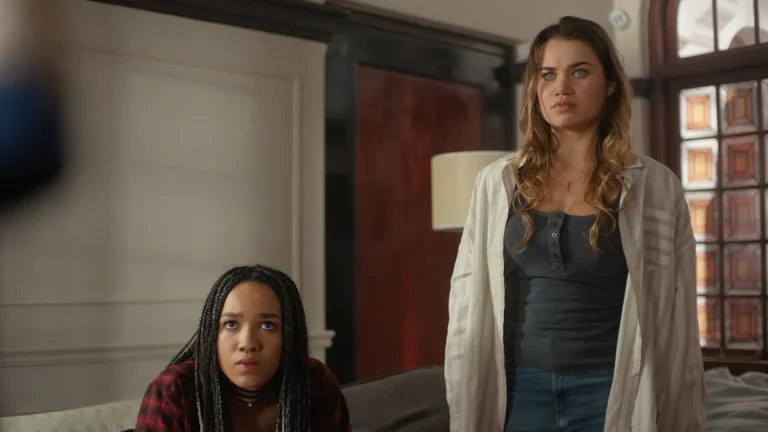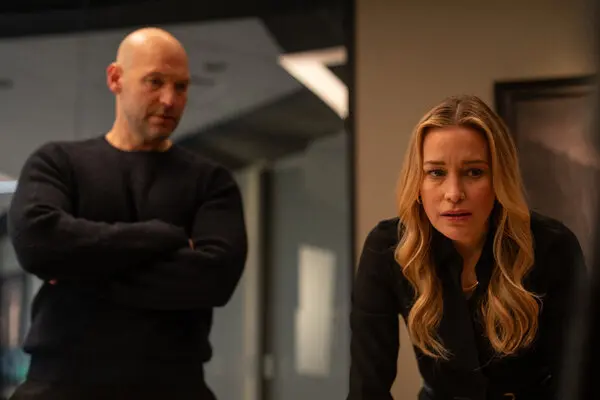Deception is one of the greatest tools at a filmmaker’s disposal. Ever since the inception of psychological thrillers, the paragons (such as Hitchcock, Scorsese, Polanski, and Christopher Nolan) have made use of ample trickery to sustain their turn-the-table plotlines, which keep a viewer right on edge the entire time. Oriol Paolo’s prowess as a master illusionist is realized in his latest film, God’s Crooked Lines, adapted from a novel of the same name by Torcuato Luca de Tena.
At the heart of this film lies a tortuous tale that cuts through layers of reality. Even though almost all pieces of the puzzle fit together, the final picture still remains inconclusive and ever-shifting. But to maintain the audience throughout this turbulence is no easy job. Paulo achieves this feat through crisp, directional techniques, haunting cinematography, and an outstanding performance by the cast.
It is fascinating how a strikingly lengthy runtime of two hours and thirty-five minutes feels like the blink of an eye. Yet there are nuances in the storyline that can only be understood retrospectively. This essay is an attempt to take apart the spliced-up plotlines and appreciate all the possibilities that the film has explored.
God’s Crooked Lines Plot Summary
One of the most curious aspects of the film is a narrative that runs parallelly, not only obfuscating timelines and adding to the element of mystery but also influencing the viewer’s opinion of ‘the truth.’ Thus, while summarizing, I will try to maintain the original structure of the story as best as possible and also delineate how it affected my immediate conclusions.
An elegantly dressed and sharp-looking woman, Alice Gould (Barbara Lennie), arrives at a psychiatric facility. She is accompanied by an elderly man who drops her off at the gate, thanks her for her courage, and takes his leave. Inside, the doctors look at her papers, and everything is found to be in order. There is a consent form from her husband and a letter recommending her admission from Dr. Donaldio, who has mentioned that the woman in question suffers from acute paranoia. He further expounds her condition as one owing to her sharp intellect; she can form an explanation for everything within seconds, thus easily manipulating anyone less intellectually capable or less experienced. This statement fails to threaten the doctor, as he feels he falls under neither of the categories.
He proceeds to a psychiatric evaluation, where it is revealed that her admission has been recommended because she has tried to poison her husband thrice with a poison that cannot be traced by urine analysis. Alice denies any such allegation. She further reassures the doctor that even though she feels a certain animosity toward her good-for-nothing husband, Helidoro (David Selvas), she has no reason to kill him. Alice is a private investigator by profession with a degree in chemistry. Although her trophy husband is a squanderer of her hard-earned wealth, he has ornamental value in her life, and there is no reason for her to get rid of him. But things were different for Helidoro; he would be the sole proprietor of his wife’s fortune if he could incapacitate her in any way.
The doctor lets the case rest and introduces her to Dr. Castell (Loreto Mauleon), the deputy director of the facility, who guides her through all the unsettling procedures of handing in personal belongings and invasive security checks. On request, Castell allows her to keep one of her books. Back in her dingy cell, she is seen scouring through newspaper cuttings and other documents that she had hidden in her books regarding the mysterious death of a boy who used to be a patient there.
The story cuts to a different timeline; it is difficult to guess precisely when. The setting is the same: a night of heavy rain. A fire has broken out in one of the wards, and all the cell doors have been unlocked. The patients are running around wild and free; everything has been thrown into chaos. All the doctors and the director are trying hard to re-establish order; we also recognize Dr. Castell as part of the team. The chief of police is also on the grounds. Together they visit one of the patients’ rooms and discover a mangled dead body of a young boy. At the same time, the camera zooms out to reveal a man with bloody hands watching from behind a door, terrified.
In the present-day timeline, Alice has made a friend in the facility; a man called Ignacio, who appears to be quite sane. He even has the privilege of carrying a lighter and cigarettes. He gives her a tour of the facility and even delineates the strange dynamics of the patients. The twins Remus and Romulus –Romulus imitates others and protects an invalid young girl with his life, who he thinks is his little sister. Remus is mute. Alice also encounters Luis Ojeda, a perverted dwarf who is hiding under her dining table and trying to molest her. Ignacio drives him away and tells her that he does that to everyone. And he also points out a gargantuan man appointed himself as Luis Ojeda’s chaperone. And thus, he gets away with his misbehavior.
In the other timeline, the doctors are brainstorming as to who might have been the murderer when one of them stumbles upon the murder weapon, a bloodied shard of glass under the bed, one that has been procured from the broken window of the room. They start interrogating their able-bodied patients one by one. We realize that the anxious man with bloody hands is none other than Ignacio. Our present knowledge that he has permission to carry a lighter makes us want to connect the dots and jump to the narrative that Ignacio lit the fire to distract the officials and killed the man, though we have no concrete proof to believe so. Soon, the doctors become aware of Ignacio’s strange behavior and discover blood on his hands. When they detain and interrogate him, he says that he was trying to help the victim when he saw him wounded.
Again, in the present, Alice seems to be acutely observant of other patients’ behavior and the proceedings of the hospital. In a session with a psychiatrist, Dr. Arellano, who seems to develop a crush on her, she tricks him into giving her the keys to the staff toilet, which she manages to clog up and cause an overflow. This distracts the guard in the archive section and buys her enough time to procure a document, a record of leave permissions for various patients, where she finds out that on the date in question, only two patients were granted leave –Ignacio and Ojeda.
Alice finds Ignacio and tells him her true motive for being there—that she has promised a dead boy’s father to solve the mystery of what happened to his son, whose death was dismissed as a suicide by the authorities. Her only lead is a note written by the murderer to the boy’s father, which says— ‘you killed him, not me.’ By analyzing the handwriting, she figured that it belonged to a person who was schizophrenic. And for him to be able to post the letter, he would have to be on leave. Ignacio appears to be uneasy but tells her that Ojeda and the dead boy used to get into a lot of fights. As he rushes to get away, Alice tries to detain him. Right then, it begins to rain, and Ignacio experiences a terrible seizure, and his skin breaks out in blisters.
In the parallel storyline, Ignacio is acquitted because he has severe hydrophobia and could not have broken the window as it was pouring outside.
At present, with Ignacio out of the equation, Alice has only one lead to follow—Ojeda. One day, she finds him pestering another woman and escaping to the woods. She goes after him but is intercepted by Romulus, who tells her – ‘I know who you are. And then he takes her to a place where he has put together a shrine with tied-up branches, which he claims to have built for his brother and sister, and says that Alice is their mother. Alice is touched by the gesture and agrees. Meanwhile, she hears something in the nearby bushes and returns to her trail. Soon, she is ambushed and overpowered by Ojeda, who tries to rape her, and she blacks out.
When she regains consciousness, she finds herself strapped to a bed. Dr. Arellano informs her that it is necessary, as she has murdered Luis Ojeda. Alice is taken aback and is unable to recall anything about the incident. She insists that if it happened, she had acted in self-defense. She reveals her true identity to Arellano, tells him about her mission and demands her release. When Arellano refuses to believe her, she says that the Director of the facility, Dr. Samuel Alvar, knew all about it and would be able to confirm her account.
When Alvar visits her, he denies any such knowledge and claims that she is suffering from paranoia and hence, delusional. Alice expounds her story in the presence of a medical board that a certain Dr. Del Olmo has hired her to investigate his son’s death. She thought of an elaborate plan to feign her illness so that she could be an insider and get access to a classified record. Nobody knew of her plans except Dr. Del Olmo, who accompanied her to the facility. Her husband, who signed the form under the pretext of bank papers, knows that she is in Buenos Aires for work. And she herself wrote the letter from Dr. Donaldio, an acquaintance. Samuel Alvar, an acquaintance of Del Olmo, has also been one of the collaborators.
But Alvar keeps on insisting that there is nothing mysterious about Damian’s death, which was a suicide, and he is not aware of any such arrangement. The tension intensifies as there is a division in the medical board regarding Alice’s diagnosis. Dr. Castell and Dr. Arellano seem to be convinced by Alice’s account when Alvar presents his own version. According to him, Alice was unable to come to terms with the fact that her husband was only interested in her money and hence tried to poison him. But when his husband finds out and mentions it to Dr. Donaldio, she twists her own reality in her head—a reality where she fakes the very illness that she is afflicted with. Dr. Alvar’s theory is sustained, as both Helidoro and Dr. Donaldio are unreachable, but when Dr. Del Olmo is summoned to the facility for verification, he is not the man who appears at the beginning of the film; Alice is unable to recognize him, and so is the viewer.
Thus, Alice is condemned to shock treatment and isolation. She is loaded with sedatives and remains passed out for days. In her reverie, she has dreamlike visions of her mutilated consciousness navigating through the recent events. When she wakes up, Dr. Castell visits her, and she tells her that it is all her husband’s conspiracy. It can only be confirmed by tracing her bank accounts, as she suspects that he has drained it by now. In order to verify this theory, Dr. Castell breaks into Alvar’s office and finds Alice’s admission file, where she finds out that her husband has indeed paid twenty times more than the regular amount for her admission. Meanwhile, Arellano visits Alice’s home and finds it empty and abandoned. He then visits the police to report this, but the chief of police refuses to acknowledge his report without the consent of the director.
All these painstaking details of the story build up to a spiraling crescendo where both the plotlines fit into each other like lock and key and pave the way for the final showdown.
God’s Crooked Lines Ending Explained
Alice figures that to access her bank records, she would have to visit the bank herself, but neither Castello nor Arellano could arrange her release. She formulated a plan to escape. She left her cell and took cover in the toy workshop with the help of Ignacio and a few others. Alvar found out and alerted the nurses and attendants. Alice informed Ignacio about her plan and asked for his lighter. She waited in the toy shed till the end of the day. Then she poured paint thinner all around and lit up the shed. Ignacio watched the flames rise from his room, and creating a distraction, he left his cell and started unlocking all the other cell doors.
At this point, the viewer realizes– this is that ill-fated night where the timeline kept switching to. All the patients are out in the open, causing mayhem. It is pouring down in torrents. But blessed by the chaos, Alice slowly paves her way to escape. Meanwhile, Ignacio comes upon a terribly wounded Romulus in his cell. He tries to help him, but he is too far gone. Soon the authorities find his body, Ignacio takes cover, and we are taken back to that previous scene.
Alice manages to reach the boundary of the facility, where a woman in a car asks her to open the gates. She introduces herself as the coroner who has come to investigate the body. Alice is nonplussed as she is unaware of any death. But she plays along and opens the gate for her. She was about to leave the gates when the lady further asked her the direction of the male ward and Romulus’s cell. This causes Alice to change her mind, debilitating the woman and exchanging clothes with her. Then re-enters the facility as the coroner and examines Romulus’s body.
Alvar and the chief are oblivious to this switch until the attendants report that Alice has been found. When Alvar she the woman, he confirms that she is not a patient in his facility, even though she is wearing the uniform. The chief then intervenes and recognizes her as the coroner.
Who killed Romulus and why?
Alvar and the chief find Alice in the examination room. She claims that the elephant man has killed Romulus, and it is evident from his broken bones that his body has been crushed under heavy weight. This hypothesis is accepted when the doctors find deep gashes from the glass shard in the elephant man’s hands. He was avenging the death of Luis Ojeda, who was killed by Romulus when trying to get his way with an unconscious Alice. And also, he was in love with the girl who Romulus referred to as his little sister and always kept near him. Romulus had taken away from him everyone he cared about.
Is Alice really insane?
The chief of police affirms that Alice’s bank accounts have indeed been emptied. The next day, a trial is held where it is unanimously agreed upon that Alice is not insane. Alvar loses his post as the director but keeps on insisting that it might be the biggest mistake on behalf of the medical board. Just as Alice begins to revel in her triumph, Alvar, while leaving, mentions that he has received a call from Dr. Donaldio the previous night, who has been on a trip with his wife. He has confirmed that there is no conspiracy and has also agreed to visit for the sake of the trial. As Alvar leaves the trial room, Dr. Donaldio enters, and he is the same man who had brought Alice to this place.
As the ending gives away nothing definitive, one can explore the possibilities it entails. If we consider Alice to be delusional, it does not explain the embezzlement. Also, why did Alvar announce Donaldio’s phone call and his presence only after he had lost all credibility? Was he having fun at the expense of the medical board? Unlike, but possible.
Yet another mind-boggling theory would be— Alice never recovered from the shock treatment, and all that ensues is an intricate dream where her idle mind solves its own puzzles. Or perhaps she is falling prey to yet another conspiracy, where Alvar employs the final trick up his sleeve— planting the ultimate seed of doubt in the minds of the board members.
Through an endless number of theories that can be construed about the film, I felt that Paulo’s most significant accomplishment is that he made us question the very nature of these theories. He further dares to propose that logic and reason are human constructs by turning them into playthings. He gives the age-old art of deduction a new perspective by presenting the human mind as an unreliable tool.








